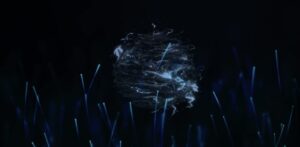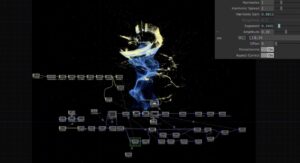In this test, I explored using microphone input to drive real-time visual changes. While the initial interaction worked, I believe the main visuals could be more expressive and exaggerated. For example, the mic input could control a wider range of parameters — such as diffusion, distortion, brightness, and more dramatic rotations — to create a more immersive, reactive effect. I’m open to experimenting with any visual responses that feel dynamic and playful.
Additionally, when I’m not blowing into the mic, the visual decay happens a bit too fast. Slowing down the rate of change when idle could help maintain a smoother and more organic visual flow.


TouchDesigner Visual Update – Version 2
In this iteration, I moved away from the original circular visual form and transitioned to a more organic, irregular shape. This change allowed the visual to feel more fluid and less constrained, resembling something between flowing matter and an energetic field.
Additional enhancements include:
-
Increased Mic Interactivity: The microphone input now drives multiple parameters simultaneously, including diffusion intensity, mesh distortion, brightness shifts, and rotation amplitude. These changes respond more dramatically to volume spikes, making the interaction more expressive.
-
Particle Responsiveness: The internal texture now breaks apart and swirls with more visible turbulence, suggesting a kind of sonic turbulence.
-
Visual Decay Tweaks: The decay time when there’s no input has been lengthened, allowing the form to fade out more gracefully rather than collapsing too fast.
-
Color Feedback: There is subtle hue shifting based on sound amplitude, helping the piece feel alive and emotionally responsive.

